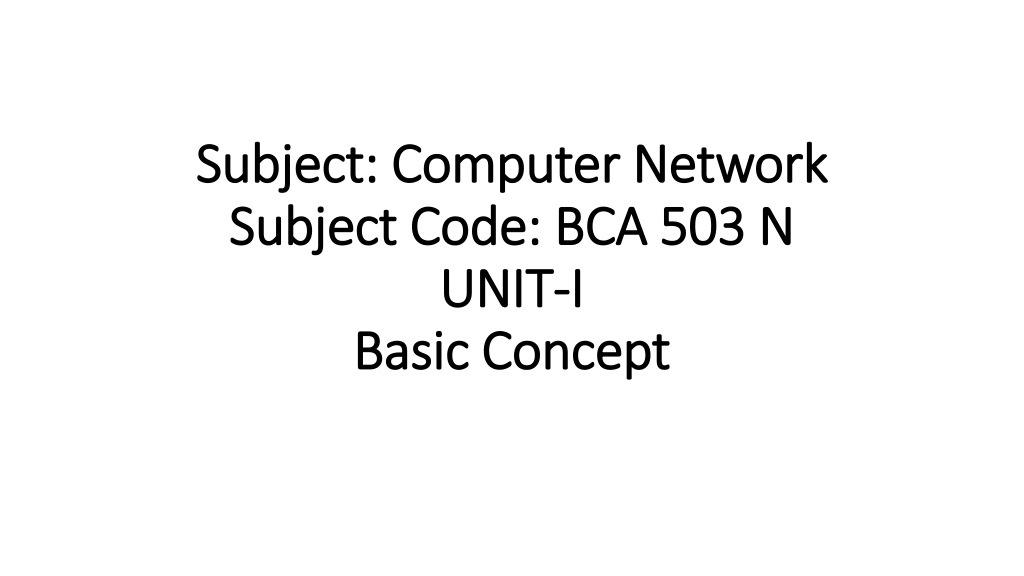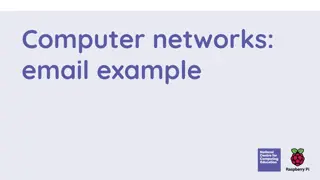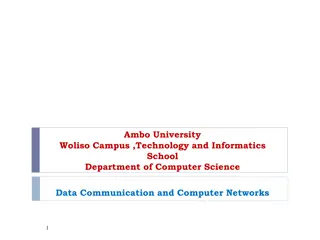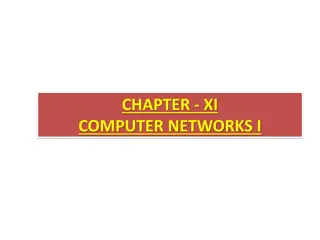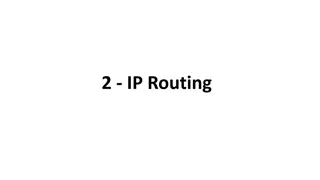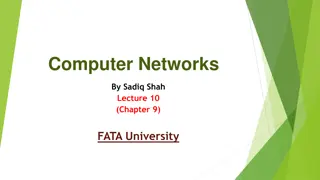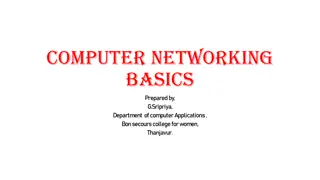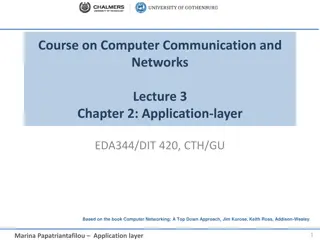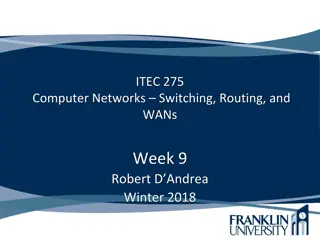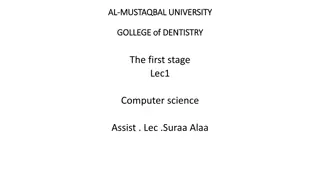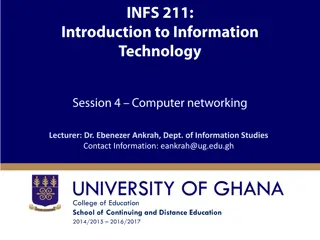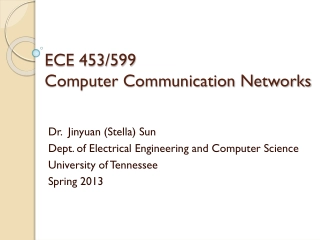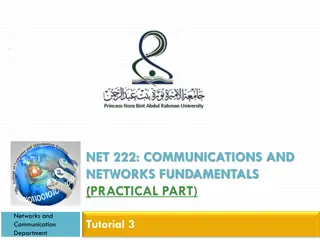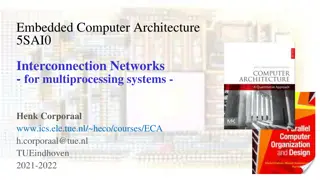Understanding Data Communication in Computer Networks
Data communication in computer networks involves the exchange of data between devices through various transmission mediums. The effectiveness of a data communications system relies on key characteristics like delivery, accuracy, timeliness, and jitter. Components of data communication include the message, sender, receiver, transmission medium, and protocol. Data representation encompasses text, numbers, images, audio, and video, with each form represented using specific bit patterns or codes.
Download Presentation

Please find below an Image/Link to download the presentation.
The content on the website is provided AS IS for your information and personal use only. It may not be sold, licensed, or shared on other websites without obtaining consent from the author. Download presentation by click this link. If you encounter any issues during the download, it is possible that the publisher has removed the file from their server.
E N D
Presentation Transcript
Subject: Computer Network Subject: Computer Network Subject Code: BCA 503 N Subject Code: BCA 503 N UNIT UNIT- -I I Basic Concept Basic Concept
Data Communication Data communications are the exchange of data between two devices via some form of transmission medium such as a wire cable. The effectiveness of a data communications system depends on four fundamental characteristics: delivery, accuracy, timeliness, and jitter. I. Delivery:- The system must deliver data to the correct destination. Data must be received by the intended device or user and only by that device or user. II. Accuracy. The system must deliver the data accurately. Data that have been altered in transmission and left uncorrected are unusable. III. Timeliness. The system must deliver data in a timely manner. Data delivered late are useless. In the case of video and audio, timely delivery means delivering data as they are produced, in the same order that they are produced, and without significant delay. This kind of delivery is called real-time transmission. IV. Jitter. Jitter refers to the variation in the packet arrival time. It is the uneven delay in the delivery of audio or video packets. For example, let us assume that video packets are sent every 3D ms. If some of the packets arrive with 3D-ms delay and others with 4D-ms delay, an uneven quality in the video is the result.
Components of Data Communication A data communications system has five components :- I. Message. The message is the information (data) to be communicated. Popular forms of information include text, numbers, pictures, audio, and video. II. Sender. The sender is the device that sends the data message. It can be a computer, workstation, telephone handset, video camera, and so on. III. Receiver. The receiver is the device that receives the message. It can be a computer, workstation, telephone handset, television, and so on. IV. Transmission medium. The transmission medium is the physical path by which a message travels from sender to receiver. Some examples of transmission media include twisted-pair wire, coaxial cable, fiber-optic cable, and radio waves. V. Protocol. A protocol is a set of rules that govern data communications. It represents an agreement between the communicating devices. Without a protocol, two devices may be connected but not communicating, just as a person speaking Hindi cannot be understood by a person who speaks only Chinese.
Data Representation Information comes in different forms such as text, numbers, images, audio, and video. Text:-In data communications, text is represented as a bit pattern, a sequence of bits (0 s or 1 s). Different sets of bit patterns have been designed to represent text symbols. Each set is called a code, and the process of representing symbols is called coding. Today, the prevalent coding system is called Unicode, which uses 32 bits to represent a symbol or character used in any language in the world. The American Standard Code for Information Interchange (ASCII), developed some decades ago in the United States, now constitutes the first 127 characters in Unicode and is also referred to as Basic Latin. Numbers: -Numbers are also represented by bit patterns. However, a code such as ASCII is not used to represent numbers; the number is directly converted to a binary number to simplify mathematical operations. Images: -Images are also represented by bit patterns. In its simplest form, an image is composed of a matrix of pixels (picture elements), where each pixel is a small dot. The size of the pixel depends on the resolution. For example, an image can be divided into 1000 pixels or 10,000 pixels. In the second case, there is a better representation of the image (better resolution), but more memory is needed to store the image. Audio: -Audio refers to the recording or broadcasting of sound or music. Audio is by nature different from text, numbers, or images. It is continuous, not discrete. Video: - Video refers to the recording or broadcasting of a picture or movie. Video can either be produced as a continuous entity (e.g., by a TV camera), or it can be a combination of images, each a discrete entity, arranged to convey the idea of motion.
Communication between two devices can be simplex, half-duplex, or full-duplex. Simplex: - In simplex mode, the communication is unidirectional, as on a one-way street. Only one of the two devices on a link can transmit; the other can only receive. For example Keyboards and traditional monitors. The key- board can only introduce input; the monitor can only accept output. The simplex mode can use the entire capacity of the channel to send data in one direction. Half-Duplex: - In half-duplex mode, each station can both transmit and receive, but not at the same time. : When one device is sending, the other can only receive, and vice versa. The half-duplex mode is like a one-lane road with traffic allowed in both directions. When cars are traveling in one direction, cars going the other way must wait. In a half-duplex transmission, the entire capacity of a channel is taken over by whichever of the two devices is transmitting at the time. Walkie-talkies and CB (citizens band) radios are both half-duplex systems. The half-duplex mode is used in cases where there is no need for communication in both directions at the same time; the entire capacity of the channel can be utilized for each direction. Full-Duplex: - The full-duplex mode is used when communication in both directions is required all the time. The capacity of the channel, however, must be divided between the two directions. One common example of full-duplex communication is the telephone network. When two people are communicating by a telephone line, both can talk and listen at the same time.
